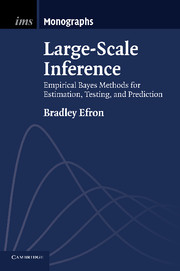Book contents
- Frontmatter
- Contents
- Prologue
- Acknowledgments
- 1 Empirical Bayes and the James—Stein Estimator
- 2 Large-Scale Hypothesis Testing
- 3 Significance Testing Algorithms
- 4 False Discovery Rate Control
- 5 Local False Discovery Rates
- 6 Theoretical, Permutation, and Empirical Null Distributions
- 7 Estimation Accuracy
- 8 Correlation Questions
- 9 Sets of Cases (Enrichment)
- 10 Combination, Relevance, and Comparability
- 11 Prediction and Effect Size Estimation
- Appendix A Exponential Families
- Appendix B Data Sets and Programs
- References
- Index
3 - Significance Testing Algorithms
Published online by Cambridge University Press: 05 September 2013
- Frontmatter
- Contents
- Prologue
- Acknowledgments
- 1 Empirical Bayes and the James—Stein Estimator
- 2 Large-Scale Hypothesis Testing
- 3 Significance Testing Algorithms
- 4 False Discovery Rate Control
- 5 Local False Discovery Rates
- 6 Theoretical, Permutation, and Empirical Null Distributions
- 7 Estimation Accuracy
- 8 Correlation Questions
- 9 Sets of Cases (Enrichment)
- 10 Combination, Relevance, and Comparability
- 11 Prediction and Effect Size Estimation
- Appendix A Exponential Families
- Appendix B Data Sets and Programs
- References
- Index
Summary
Simultaneous hypothesis testing was a lively topic in the early 1960s, my graduate student years, and had been so since the end of World War II. Rupert Miller's book Simultaneous Statistical Inference appeared in 1966, providing a beautifully lucid summary of the contemporary methodology. A second edition in 1981 recorded only modest gains during the intervening years. This was a respite, not an end: a new burst of innovation in the late 1980s generated important techniques that we will be revisiting in this chapter.
Miller's book, which gives a balanced picture of the theory of that time, has three notable features:
It is overwhelmingly frequentist.
It is focused on control of α, the overall Type I error rate of a procedure.
It is aimed at multiple testing situations with individual cases N between 2 and, say, 10.
We have now entered a scientific age in which N = 10 000 is no cause for raised eyebrows. It is impressive (or worrisome) that the theory of the 1980s continues to play a central role in microarray-era statistical inference. Features 1 and 2 are still the norm in much of the multiple testing literature, despite the obsolescence of Feature 3. This chapter reviews part of that theory, particularly the ingenious algorithms that have been devised to control the overall Type I error rate (also known as FWER, the family-wise error rate).
Information
- Type
- Chapter
- Information
- Large-Scale InferenceEmpirical Bayes Methods for Estimation, Testing, and Prediction, pp. 30 - 45Publisher: Cambridge University PressPrint publication year: 2010
